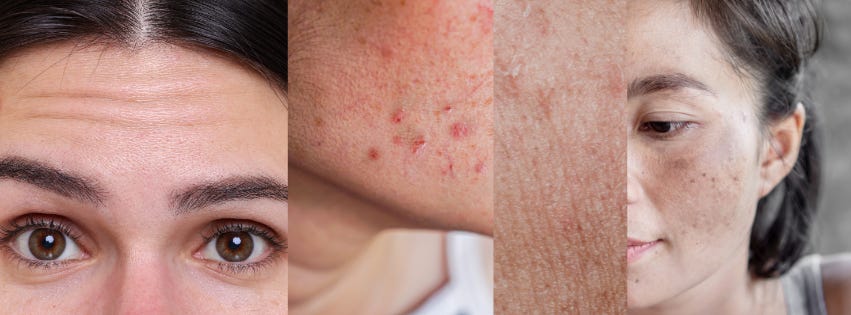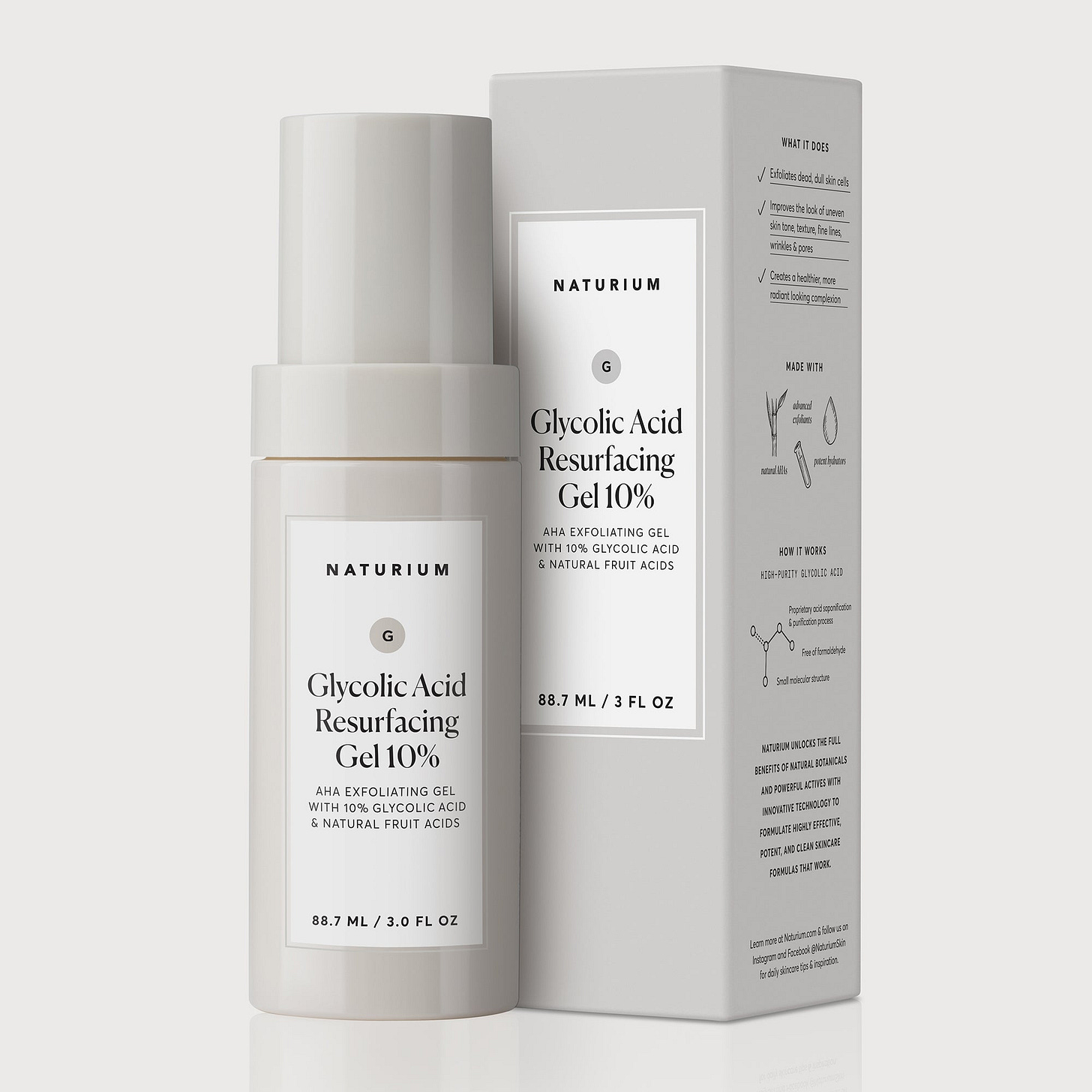Salicylic Acid vs Glycolic Acid: Which One Is Right for You?
Choosing Between Salicylic Acid and Glycolic Acid for Your Skin Type
Let me explain this quickly:
Salicylic acid will be more effective for people with oily skin while glycolic is more suitable for people with dry or mature skin.
Generally, salicylic acid is more gentle than glycolic due to its larger molecular size.
Therefore, it may be more suitable for people with oily and sensitive skin.
Glycolic acid is a powerful ingredient that can be used to treat hyperpigmentation and signs of aging.
While both acids have a place in your skin care routine, you may want to avoid layering them together as it may cause irritation.
In this article, I will explain everything you need to know about salicylic acid, glycolic acid, and which one is right for you.
What’s salicylic acid?
Salicylic acid is an exfoliating acid and popular active ingredient commonly found in skincare products.
Also known as a beta hydroxy acid, salicylic acid is used to treat acne and clogged pores thanks to its fat soluble nature.
Generally, salicylic acid is better suited for people with sensitive skin than other acne treatments like benzoyl peroxide.
You will commonly find salicylic acid included in products like cleansers and toners to treat textured skin and blackheads.
What’s glycolic acid?
Known for boosting collagen production and fighting hyperpigmentation, glycolic acid is a popular alpha hydroxy acid.
Because of its relatively small molecular size, glycolic acid is one of the strongest alpha hydroxy acids.
In fact, glycolic acid is stronger than mandelic acid or even lactic acid.
It’s useful to:
Improve skin texture
Unclog pores
Treat acne breakouts
Stimulate collagen production
At the same time, glycolic acid may be too strong for people with sensitive skin.
Comparison: Glycolic Acid and Salicylic Acid
Both glycolic and salicylic acids provide exfoliation properties, but they work differently!
One might be better for you than the other depending on your skin type and sensitivity.
Benefits
Salicylic acid has benefits like fighting clogged pores and dissolving dead skin cells to treat blackheads.
At the same time, glycolic acid benefits include stimulating collagen production and brightening dull skin.
Strength
Glycolic acid is stronger than salicylic acid.
Therefore, it is not as suitable for people with sensitive skin as salicylic acid.
If you’re looking for an alpha hydroxy acid that can provide some of the same benefits as glycolic, check out how mandelic acid compares to salicylic acid.
Skin Types
Because alpha hydroxy acids have hydrating properties, glycolic acid is more suitable for people with dry skin.
Further, glycolic acid can help stimulate collagen production, so it can be helpful for people with mature skin.
On the other hand, if you have oily or acne prone skin type, salicylic acid will be more effective.
Skin Concerns
Both acids are effective, but they have different strengths and weaknesses when it comes to treating skin conditions.
Skin Concerns: Salicylic Acid
Salicylic acid is effective at treating skin concerns like:
Blackheads
Acne
Seborrheic dermatitis
Excess oil production
Skin Concerns: Glycolic Acid
Alternatively, glycolic acid is effective at treating:
Signs of premature aging
Acne
Dull skin
Hyperpigmentation
Side Effects
Both salicylic acid and glycolic acid can cause similar side effects like:
Dryness
Flaking skin
Redness
Irritation
Because glycolic acid is stronger, it is more likely to cause side effects than salicylic acid.
Is glycolic acid the same as salicylic acid?
No, glycolic acid is not the same as salicylic acid.
Glycolic acid is an alpha hydroxy acid that is effective at treating hyperpigmentation and signs of aging.
On the other hand, salicylic is a beta hydroxy acid that is used to treat acne prone skin and blackheads.
While they are both categorized as exfoliating acids, both acids work differently and different benefits.
Should I use salicylic acid or glycolic acid?
If you have mature skin or hyperpigmentation, you should use glycolic acid.
However, if you have acne prone or oily skin, you should use salicylic acid.
Is glycolic or salicylic acid better?
Glycolic acid is better at treating mild hyperpigmentation and uneven skin tone.
On the other hand, salicylic acid is better for people with acne prone or sensitive skin.
Both glycolic acid and salicylic can help treat acne breakouts and unwanted skin texture.
Can I use salicylic acid and glycolic acid together?
To avoid irritation, you should not layer salicylic acid and glycolic acid together.
It’s pretty similar to how you should avoid using salicylic acid and benzoyl peroxide together.
However, you can consider using them at different times of day if you want to use both in your skincare routine.
For example, you can try using salicylic acid in the morning and glycolic acid at night.
Just be sure to monitor your skin for signs of irritation like redness or itchiness.
If irritation does occur, stop using exfoliating acids and focus on barrier repair instead.
Product Recommendations
For Salicylic Acid (Best for Oily/Acne-Prone Skin):
Paula’s Choice Skin Perfecting 2% BHA Liquid Exfoliant: This leave-on exfoliant helps unclog pores, smooth texture, and fight breakouts using 2% salicylic acid. Its watery texture sinks in fast without feeling sticky, making it a go-to for oily or acne-prone skin. Plus, it’s fragrance-free and gentle enough for daily use.
CeraVe Renewing SA Cleanser: A gentle daily cleanser that exfoliates with salicylic acid while hydrating the skin with ceramides and hyaluronic acid. It removes dirt and oil without drying you out and works well for rough, bumpy, or acne-prone skin.
Sunday Riley U.F.O. Ultra-Clarifying Face Oil: This face oil combines salicylic acid with black cumin seed oil and milk thistle to help clear congested pores and prevent breakouts. It's suitable for oily and acne-prone skin.
For Glycolic Acid (Best for Dry/Mature Skin):
Naturium Glycolic Acid Resurfacing Gel 10%: This serum combines glycolic acid with fruit acids to gently exfoliate and resurface the skin, promoting a brighter and more even complexion.
TNR Glycolic Acid Cleanser: A gentle cleanser that helps exfoliate the skin without causing irritation, making it suitable for those with dry or mature skin.
Medik8 Sleep Glycolic – A time-release overnight treatment with 10% glycolic acid that gently resurfaces dull, textured skin while you sleep, ideal for dry or mature skin types.
Tip: Always introduce active ingredients slowly and monitor your skin for irritation, especially when using acids.
Summary: Glycolic Acid vs Salicylic Acid
In conclusion, both glycolic and salicylic have effective exfoliating properties, but they work differently.
Glycolic acid is an AHA that is more effective at treating dark spots and signs of aging.
Further, salicylic acid products are more effective at treating acne prone skin and other oily skin concerns.
While the two can be used together, you should take caution to avoid over exfoliating and inducing irritation.
However, when used correctly, these exfoliating acids can be incredibly effective additions to your skincare routine.
Cheers,











